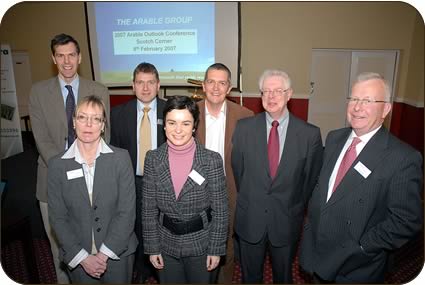Jennifer MacKenzie is an agricultural photo journalist with almost 30 year's experience. Operating from her base in Cumbria, Jennifer undertakes mainly industry-related freelance writing and photography.
Arable Prospects are Good
Future prospects for the North’s arable farmers are improving against a background of an increasing demand for biofuels, a growing world population and global warning The Arable Group’s biennial Outlook conference at Scotch Corner was told by a line-up of keynote speakers.
 |
| Back left to right, Andrew Wells, Colin MacEwan, Guy Smith, Ian Crute, front left Clare Wenner and Carmen Suarez with conference chairman Julian Cook, right. |
More than 180 people, the majority of them arable farmers, attended the conference on Thursday February 8th 2007 which was addressed by Ian Crute, director of Rothamstead Research, Clare Wenner, head of transport biofuels Renewable Energy Association, Carmen Suarez, the NFU’s chief economist, Andrew Wells, principal consultant for TAG Consulting, Guy Smith an arable farmer and writer, and Colin MacEwan, TAG chief executive.
The challenges created by a changing environment were also an opportunity for producers in crop-based agriculture.
However, if the UK was to grasp this opportunity it was vitally important to hold onto a research and development base, scientist, director of Rothamstead Research and Newcastle University graduate Ian Crute told the conference. Too low a priority was being placed on skills and research.
And he also warned that emphasis was possibly being placed on the wrong problems – such as the number of skylarks per hectare rather than carbon emissions – and not doing enough to keep the next generation on the land.
“Globalisation, international development, population growth, energy security, regulatory regimes, the ‘green agenda’ and even national security issues are just some of the major issues that influence the business of crop-based agriculture,” said Professor Crute.
“At the start of the 21st century, crop-based agriculture faces a great challenge which is also a great opportunity. Human civilisation ‘runs’ on photosynthesis that occurred more than 100 million years ago – sooner or later we will have to start running on other energy and that includes ‘real-time’ photosynthesis,” he added.
Of the earth’s 13 billion hectares, 8.7 billion would support plant life. To support six billion people, currently 1.5 billion hectares was cropped.
Professor Crute said if it was not for advanced crop protection practices, the cropped land area to feed today’s population would be four billion hectares and doubling by 2025.
“However, we know that we will need to produce fuel and energy and food from the available land. This will only be done by major elevation in efficiency and per hectare productivity,” he said.
“The projected increased global demand by 2050 could theoretically be produced from plant biomass occupying about five pc of the global land area – the same area as that currently used for cereals.”
A balance between land use for food crops and energy would need to be struck. Food crops for energy use will be important but energy from perennial crops such as short coppice rotation would dominate, he said.
Clare Wenner, head of transport biofuels with the Renewable Energy Association said plants were going to be the future for energy production.
“Five years ago when I started down this route there wasn’t a great deal of interest – it was another fad. Certainly that’s not the case now and it is very clear in the policy-makers’ minds that biofuels have an important part to play,” she said.
Fuel security was the main factor driving the United States to develop its biofuels industry.
“Our government, after a lot of consultation, decided it would introduce the Renewable Transport Fuel Obligation which comes into effect in 2008. I worry whether the UK government is taking it seriously enough,” she said.
Biofuels offered a solution to climate change and fuel security – but it was no silver bullet, she added.
 |
| delegates at the conference |
Farming in the future will be far more complicated than simply concentrating solely on producing what the market wants as efficiently as possible.
That was the message to the conference from Guy Smith who farms combinable crops in Essex and who is also a journalist.
“Firstly we must convince policy makers and tax payers that agriculture delivers ‘environmental goods’,” he said.
“Farmers must involve themselves in the argument as to what these environmental goods are and what they are worth in terms of bio-diversity, green sensibilities and reducing the carbon footprint.”
He said farmers needed to monitor the ecology of their units and promote the positives.
Tomorrow’s successful farmer was not only one who produced efficiently but who also communicated effectively, reminding people that the British countryside was a working and productive landscape and lobbying for the agricultural cause to secure market advantages for home produced biofuels.
Without the Single Farm Payment the average farmer, based on tenanted costings, would have lost money, according to the NFU’s chief economist Carmen Suarez.
Survey data showed that while cereal farms received 55 pc of revenue from crop output, 21 pc came from the SFP with 5 pc from agri-environment schemes and 19 pc from, other sources such as livestock and diversification.
“The bottom line is that the SFP is still crucial to arable enterprises so it is important to try to assess the nature of those payments – how much and when the payments are to be made and for how long,” she said.
In 2007 25 pc of agri-support would go into rural development, increasing to 80 pc in 2012.
Crop revenues would be influenced by the reduced stocks to use ratio with consumption outstripping production for the last few years.
Demographics including improved incomes in South East Asia leading to a demand for more meat and therefore animal feed, the effects of climate change which had already reduced Australia’s grain harvest by 60 pc and the demand for biofuels would all influence revenue.

